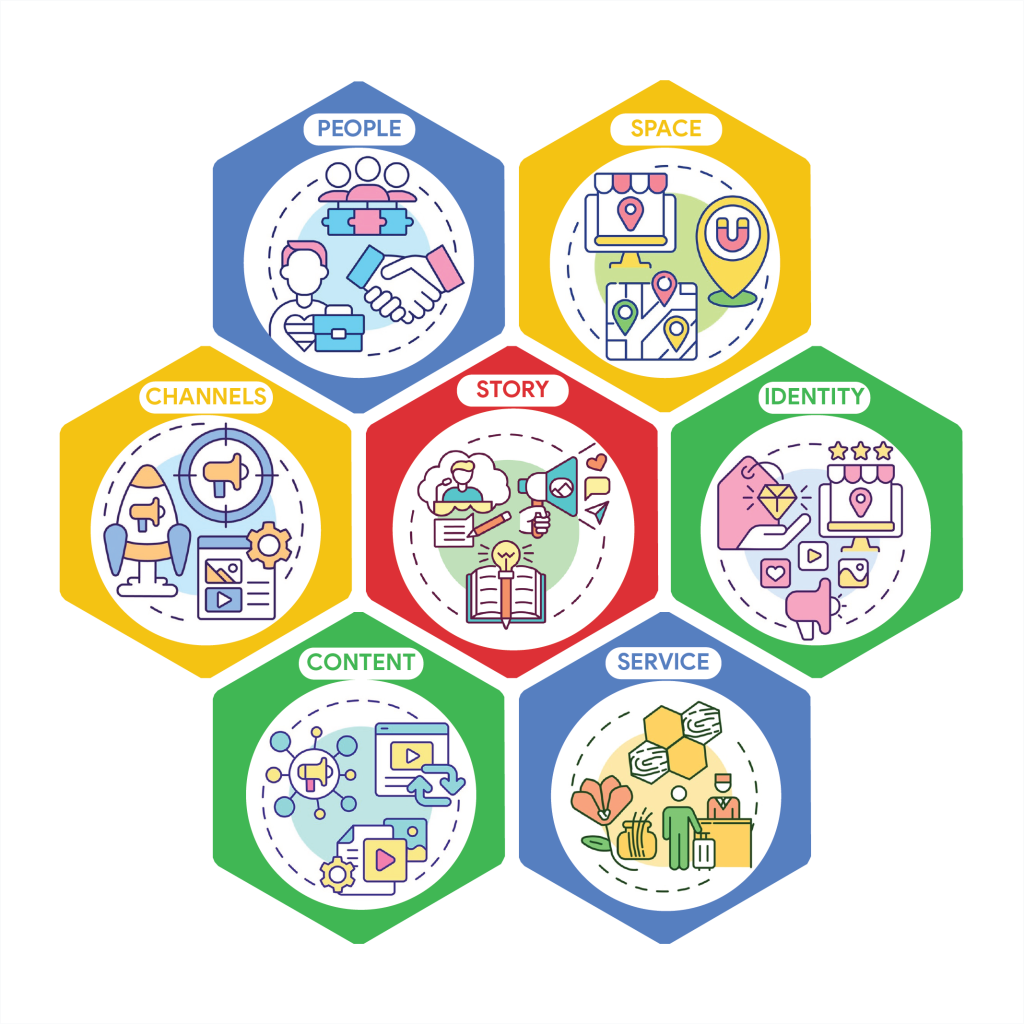The 7 Components Of Designing A Hotel Concept
THE STORY: “A story conveys why guests should stay at your hotel, beyond the bed and breakfast.”
THE PEOPLE: “Hotels might sell rooms, but relationships are the real currency.”
THE SPACE: “Your hotel space must be aligned with your core story.”
THE IDENTITY: “The identity must be fully coherent with the story of your hotel.”
THE SERVICE: “Consider which services actually add value to the guest experience.”
THE CONTENT:“Content creation rarely generates instant results. It’s a marathon, not a sprint.”
THE CHANNELS:“Channels represent all the marketing touchpoints between you and your guests.”


THE STORY
“A story conveys why guests should stay at your hotel, beyond the bed and breakfast.”
The Story defines the role of a hotel as well as its aspirations.s. In other words, your story conveys why guests should stay at your property, beyond just getting a room and breakfast.
To create an engaging – and lasting – story, it is important to make it the starting point of your concept building process. The story is like a golden thread connecting all the components of your concept, hence the importance of having a clear picture of it before working on the rest. A story should consider the hotel’s customer segments, staff and management, as well as its location and infrastructure.
THE PEOPLE
"Hotels might sell rooms, but relationships are the real currency."
The People component encompasses all the people who play a part in your hotel concept: Your employees, your guests, your partners and, to a certain extent, your investors. Together, they bring your concept to life. In most hotel concepts, people are at the core of all interactions.
The people you hire and collaborate with must all feel connected to your story. A hotel that tells a story about “connecting people and ideas” could involve local entrepreneurs, academics, and venture capitalists. For example, A hotel wishing to “lead people to better health” may partner with medical professionals, yoga studios or fitness coaches.


THE SPACE
“Your hotel space must be aligned with your core story.”
The Space component relates to the physical makeup of the hotel. It encompasses the zoning, the customer flow of a hotel, as well as its interior design. A hotel space must match with its core story: a “rebel story hotel” should be designed differently than ‘a conservative elite hotel’.
Zoning is the first and most essential step to planning your hotel space, as it greatly impacts the customer experience. Different spaces have different purposes and require sensible placing: a quiet library space will not do well if located next to a busy restaurant or hotel bar.
Interior design should come last in the space design process. The brief should consider the story, as well as both zoning and customer flow. Integrating these variables upstream of the design process lets interior designers focus on aesthetic quality to bring your story to life with the right combination of furniture pieces, textiles, materials, and decorative objects.
THE IDENTITY
“The identity must be fully coherent with the story of your hotel.”
The Identity element in the framework encompasses all the graphic, verbal, and sensorial aspects of a hotel concept. From corridor signage to website layout and up to the hold music, each and every ingredient is an opportunity for a hotel to assert its unique identity. Since these items are experienced by guests before, during and after their stay.
The visual identity you develop also extends to the content you create. Your Instagram posts, trade show banners, YouTube videos – make sure that your content is always “on brand”. Repetition and Consistency will help ingrain your concept in the mind of customers.


THE SERVICES
“Consider which services actually add value to the guest experience.”
The framework’s Services component covers the services and amenities offered to guests before, during and after their stay. Spanning everything from the essential (Wi-Fi, housekeeping) to the exotic (concierge, selfie assistant), services offer a myriad of possibilities for guest interactions, and help enrich the customer experience. Of course, services that tie in with your hotel story are particularly valuable, as they can strengthen your overall concept.
The degree of technology is also important. While a free – and reliable – Wi-Fi connection is now considered a commodity in most hotels, some establishments also offer Bluetooth speakers, connected TVs with Netflix or Apple TV, or chatbot concierges available anytime, anywhere. It’s important to consider which of these services add value for your guests, and whether they make sense in relation to the story.
THE CONTENT
“Content creation rarely generates instant results. It’s a marathon, not a sprint.”
Content component defines the intellectual property and communication assets a hotel develops. These come in many forms, from website articles to a line of fashion accessories. It might have a weekly podcast series about unconventional travel destinations or perhaps a short documentary showcasing your region. Good content can help you showcase multiple facets of your story, which helps to educate your target audience, improves your brand’s reputation, and generates free press. It will also help you stay in touch with your guests even if they’ve only been to your property once.
When creating content, it’s important to make sure it aligns with your story and that the format is consistent with your identity. This creates a positive feedback loop around your key messages, giving a valuable boost to your visibility and reputation.


THE CHANNELS
“Channels represent all the marketing touchpoints between you and your guests.”
The Channel component in our framework encompasses all digital channels as well as the real-world activities and events a hotel organizes to bring their story to life. From your OTA booking page to your end-of-year theme party.
Digital channels include booking platforms and social media accounts. But the overwhelming amount of information available online makes it incredibly difficult to create an emotional connection with guests via these channels alone. Face-to-face interactions are hard to beat when it comes to engaging people. These elements combined will make the story come alive. Depending on your story and concept, possible activities might include a flea market, movie nights, modern art exhibitions or outdoor Pilates classes.
Channels can also take the form of collaborations and, in certain cases, drive direct bookings to your hotels.
